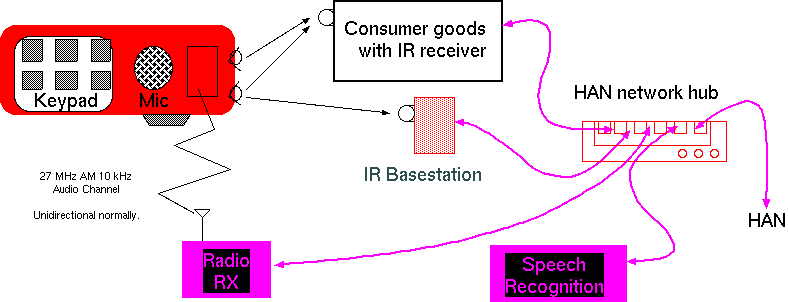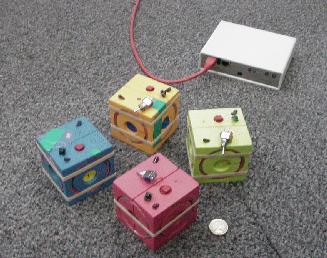
`Media Cubes and Rabbit Summary'DJ Greaves, A Blackwell, University of Cambridge.Autohan and Event ProjectsIn AutoHan we are building a user interface architecture for the home network. We believe that infra-red is an important medium for the home and that people will continue to use remote controllers of increasing sophistication. Some controllers will stay put in a room and others will be carried around and worn. Some contollers will continue to be provided with consumer goods but others will much more general purpose. We wish to use this new generation of controllers both for real-time control of the network and for programmming the home to set its future actions and behaviour. A major semantic issue with the controllers of today is that they must be pointed at the object under control. In this work, we want to point at things not immediately to hand, such as the heating boiler, and also more abstract things, such as the a radio programme on a given channel at a future date. We also want to combine controllers together or point them at each other to achieve advanced operations in a natural way. One of the programming languages we want to generate from the controllers is Iota and another is Cambridge Event Langugage (CEL). As mentioned, we also wish to continue to use the controllers for real-time control of the environment, as we do today. The Rabbit Wand is one example of a new generation controller. The Media Cubes provide something to point at to iconify the abstract entities and then go further, when we combine cubes to form a programming language. Rabbit WandThe Rabbit Wand is an IR controller with a microphone input and both narrow and wide infra-red beams. If the narrow beam is like a visable laser pointer, very accurate pointing is possible. We might envisage a consumer device with a number of little targets that can be pointed at when it is occasionally necessary to do some fine control function. The contoller can be used to point at devices and the speech input function processes demonstrative adjectives for correlation with the devices being pointed at. A motion sensor or solid-state gyro could be included cheaply in the rabbit. |

Rabbit Network AchitectureThe Rabbit probably does not do speech recognition itself, but instead puts the voice over a DECT-style link to a network receiver node. The receiver node relays the audio over the home network to a server running the speech recognition function and other software. We are working on this other sotfware. |

Media CubesThese cubes may be placed next to each other in various configurations to write programs and implement real time home control. They can also be pointed at by an IR wand. Our first media cubes are cubic and have one button. This is deliberately very different from an IR contoller. We expect our final controllers to be somewhere in between the two, preserving the power and tactile nature of current IR controllers while supporting the adjaceny facilties of cubes.  The Media Cubes pictured here are early prototypes. Each cube has a bidirectional infra-red link to the IR basestation (also pictured), and can be pointed at with the Rabbit Wand or other IR controller. The face of each cube has an induction coil, which allows it to detect adjaceny with other cubes. These coils should be covered over with graphic sheets that indicate the function of each face of each cube, but these sheets are missing in the photo. Having induction coils, batteries and IR tranceivers on each cube is not seen as a long-term technology solution. These prototypes are just to experiment with the cube language and concept. In the long run, cubes are intended to be much cheaper than today's infra-red controllers. We also envisage virtual cubes which can be manipulated on a display device and that home programming information can be displayed with cubes. Simple Example of Cube UseIf we point the television IR controller at the TV and press `1' it turns on the TV on BBC-1. If instead we point the same controller at the `time' cube and set the little display on the time cube to some time tomorrow, then pressing the `1' button on the IR controller defines a one-time program to turn on the TV on BBC-1 at that time tomorrow. If we point the controller at the `when' cube and place another cube which has been associated with receiving DTMF messages by telephone on the correct side of the `when' cube, then we can generate a program to turn on the TV on channel 1 when we dial in with a given code. ConclusionThe cubes may be thought of as infra-red remote controllers with one or two buttons. They are at the extreme other end of the spectrum from our current infra-red controllers that bristle with buttons. We shall soon have made some more combi-cubes that have more controls on them yet which can still be combined with each other. Watch this space.END. |